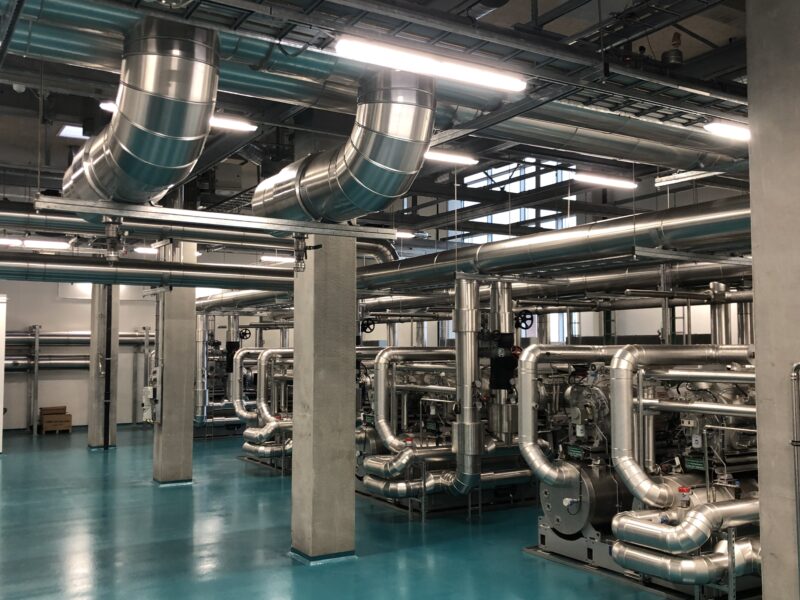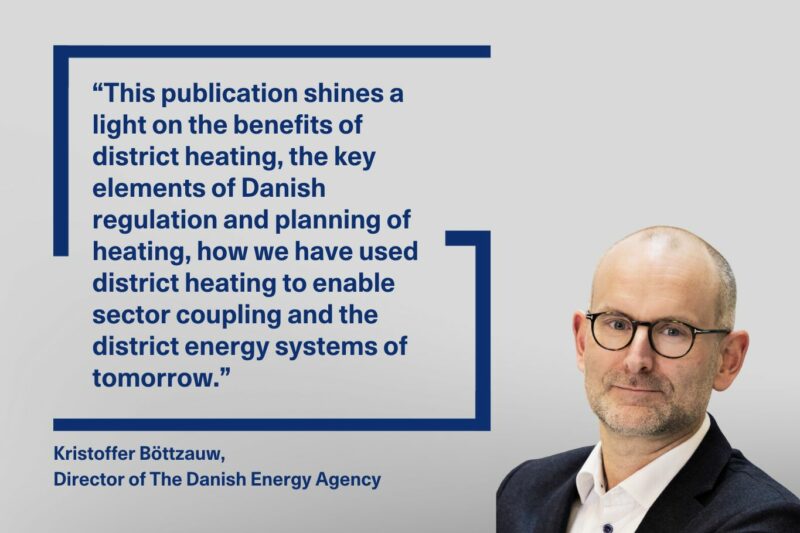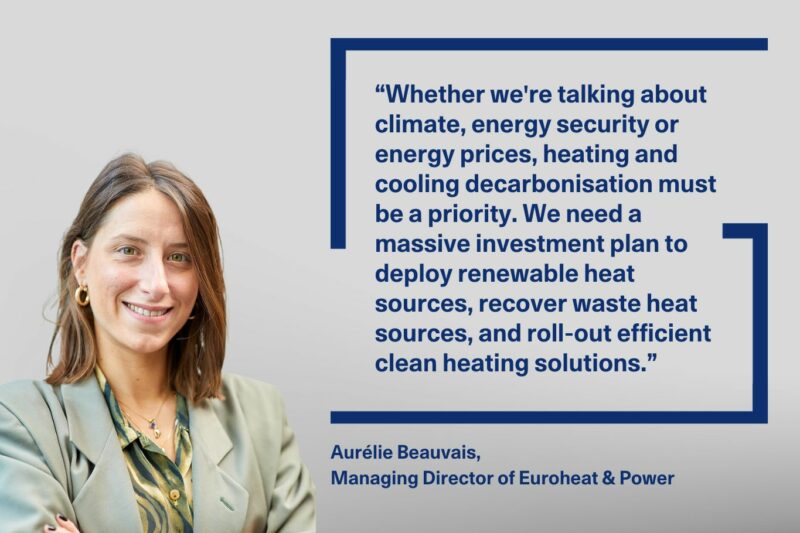News
Combined heat and power production
District heating
Energy efficiency in buildings
+2
New White Paper on District Energy


- Download white paper “District Energy – Energy Efficiency for Urban Areas
In its simplicity, district energy is about moving water, with a valuable temperature, from the place of production to the place of consumption. The efficiency of the system is created in all three parts; creating heated or chilled water, avoiding heat loss in the distribution as well as effective connection and use on the consumer side.
Denmark’s strong drive towards implementation of district heating was a result of the oil shocks of the 1970s. Completely dependent on imported oil for decades, Denmark was shaken by the oil crisis. Subsequently, comprehensive analysis of different alternative heat supply options clearly showed that district heating in many areas was the best solution, therefore, Denmark passed its first heat supply law in 1979.
- Read more about District Heating and Cooling
“Based on this law, Danish stakeholders have developed a political framework to implement district heating successfully across Denmark and gained valuable experience over the past four decades. This has also spurred the growth of numerous companies, who deliver state-of-the-art technologies and know-how within all parts of the value chain of district energy systems”, explains Lars Chr. Lilleholt, Danish Minister of Energy, Utilities and Climate in the foreword of the white paper.
Image: Overview of a district heating system. Heat is either produced or
collected as surplus heat from many sources (bottom part of illustration), then
pumped through highly effective district heating pipes to the end users. Through
the storage facility, it is possible to decouple production over short or longer
periods of time – even months. With several production facilities, the economy of
the district heating system can be optimised continuously. The end user will enjoy
heat delivered from the best available source and not be stuck with just one fuel
option.
“Today, 63% of all Danish residential homes are connected to district heating – not only for space heating, but also for domestic hot water. When producing heat and power using CHP, the overall energy efficiency is significantly higher than when producing heat and power separately. A CHP plant may have a total efficiency (combined heat and power) of 85-90% resulting in an overall fuel saving of approximately 30%, compared to separate production of heat and electricity. District heating and CHP have been – and continues to be – a key ingredient to Denmark’s green transition”, explains Morten Bæk, Director General of the Danish Energy Agency.
Image: The official launch of the white paper at E-world in Essen, Nordrhein-
Westfalen. The German state of Nordrhein-Westfalen and Denmark became strong
partners on the joint pathway towards a sustainable energy future. Denmark has
the ambition to become independent of fossil fuels by 2050 and, at the same time,
become the cleantech hub of Europe. This offers business opportunities for investors.
The heat markets in Nordrhein-Westfalen and Denmark are characterised by a high
share of district heating, which offers the opportunity to exchange knowledge and
experiences on solutions and challenges.
Energy Efficiency First
The white paper is published at a time of strong international demand for energy-efficient solutions. In view of the strategic objectives for the EU to become the world leader on renewable energy and to have the "energy efficiency first" principle at the core of its energy policy, there is the need to fully harness the potential of the heating and cooling sector in proportion to the size and importance of heating and cooling in the EU economy. Heating and cooling represent around half of the EU energy consumption, and more than two thirds of heating and cooling (84%) is still generated from fossil fuels; only around 16% is generated from renewable energy. Therefore, the sectors' contribution is key to achieve the EU objectives on decarbonisation, demand reduction, security of supply and competitiveness.
- Read more about Energy Efficiency
“Competitiveness as an aspect for getting involved in energy efficiency has in recent years also gained more awareness on the political agenda. Increasing energy prices in most of the world increase the value of energy saved. Technological innovation and the fact that low hanging fruits reappear due to changes in e.g. production volume or input mix, underline the hidden opportunities of investing in energy efficiency measures. Furthermore, investments in energy saving projects in the industry often offer a surprisingly short payback time”, said Dr Fatih Birol, Executive Director of the IEA in State of Green’s white paper on energy efficiency.
District Heating Holds Strategic Importance
Energy-efficient district heating is thus of strategic importance to the European Union member states and has great potential in the rest of the world. There is a need to increase focus in exploiting all available sustainable energy sources in the best possible way. This means utilising surplus heat from any source, replacing fossil fuels with renewables such as solar and biomass, and ensuring integration between electricity and heat.
“District heating provides an answer to these challenges and should therefore be considered as the backbone of tomorrow’s urban communities and smart cities. The establishment of district heating can gradually cover the entire urban community. Copenhagen is a good example. Here is all started with one small local system in 1903 and now 98% of the city is supplied by district heating”, explains Lars Gullev, Managing Director of VEKS and Chairman of DBDH.
Coincides with the Launch of the EU Strategy for Heating and Cooling
The official launch of the white paper at E-world in Essens coincides with the EU Strategy for Heating and Cooling, which includes the contribution from heating and cooling to realising the EU's energy and climate objectives.
The sector is key to Europe’s competitiveness, supply security, international trade position, jobs and the wellbeing of EU citizens. Heating and cooling is a major factor in social integration, the spending power and the poverty level of EU citizens.
Yet there is an insufficient understanding of the heating and cooling sector, as it has so far not been subject to a dedicated EU level assessment treating the sector as a whole. The energy saving potential of heating and cooling and the possible policies to mobilise the sector's contribution to the EU's energy and climate objectives has not been sufficiently assessed, nor is it harnessed. Heating and cooling accounts for around half of the EU energy use and, according to the available scenarios, it will remain the largest energy demand driver also in the long-term.
- Read more about the EU Strategy for Heating and Cooling
“The technological advancements favour further use of district heating. The temperature of the water required in a district heating system is becoming even lower, thereby increasing energy efficiency. This provides economic rationale for more use of surplus heat from industry and for the use of thermal energy storage. Buildings are expected to become still more energy-efficient in the future, thus having a smaller demand for energy per square meter. However, the demand for space and comfort is increasing, which increases the energy demand. Therefore, efficient low-temperature district heating solutions will play an increasing role in the future”, explains Hans Peter Slente, Senior Advisor, Danish Energy Industries Federation.
Inside this White Paper: District Energy - Energy Efficiency for Urban Areas
This white paper highlights the following:
- District energy at its core: Fuel flexibility and secure supply
- Planning and regulation – a prerequisite: The regulatory process, responsibilities and requirements
- Fuel flexibility allows for sustainability in district heating: The key to intelligent use of energy
- The necessity of heat storage: Saving money and securing supply
- The future of district energy: Realising a strong global potential
- Download white paper “District Energy – Energy Efficiency for Urban Areas
You should consider reading
solutions
Combined heat and power production
+6
CopenHill: The story of the iconic waste-to-energy plant
20 November 2024solutions
Energy efficiency in buildings
+2















